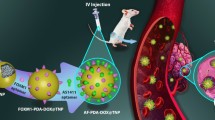Abstract
In current research, a novel coordination polymer based on Cu(II) having a 1D spiro-like chain architecture has been created with the reaction between HL (4-(4-(2-chloroimidazo[1,2-a]pyridin-3-yl)-[2,3′-bipyridin]-6-yl)benzoic acid), the custom designed organic ligand and Cu(NO3)2·3H2O under the reaction conditions of solvothermal, and its chemical formula is [Cu(L)2]·2DMF·3H2O (1). At first, the real-time RT-PCR was accomplished for the determination of the miRNA9 expression level in normal tissue and liver cancer tissue. And the compound’s influence on the miRNA9 relative expression in the cancer cells was next investigated as well. The western blotting assay was in-depth employed for the determination of the PDGF signaling pathway expression in the liver cancer cells after treated with the new compound. In the end, we investigate the direct regulation of miRNA9 on signaling pathway of PDGF by luciferase reporter gene analysis and bioinformatics analysis. Suggested by the simulation of molecular docking, it is found that the carboxyl group of Cu complex could bind to probe protein, at the same time, the pyridine ring also could bind to the probe protein, and therefore suggested that the Cu complex exhibited excellent biological activities.








Similar content being viewed by others
References
Gravitz L (2014) Liver cancer. Nature 516:S1
Anwanwan D, Singh SK, Singh S, Saikam V, Singh R (2020) Challenges in liver cancer and possible treatment approaches. Biochim Biophys Acta Rev Cancer 1873:188314
Wang L, Cho KB, Li Y, Tao G, Xie Z, Guo B (2019) Long noncoding RNA (lncRNA)-mediated competing endogenous rna networks provide novel potential biomarkers and therapeutic targets for colorectal cancer. Int J Mol Sci 20:5758
Vamsikrishna N, Daravath S, Ganji N, Pasha N (2020) Synthesis, structural characterization, DNA interaction, antibacterial and cytotoxicity studies of bivalent transition metal complexes of 6-aminobenzothiazole Schiff base. Inorg Chem Commun 113:107767
Wang F, Tian F, Deng Y, Yang L, Zhang H, Zhao D, Li B, Zhang X, Fan L (2021) Cluster-based multifunctional Copper(II) organic framework as a photocatalyst in the degradation of organic dye and as an electrocatalyst for overall water splitting. Cryst Growth Des 21:4242–4248
Fan L, Zhao D, Li B, Wang F, Deng Y, Peng Y, Wang X, Zhang X (2022) Luminescent binuclear Zinc(II) organic framework as bifunctional water-stable chemosensor for efficient detection of antibiotics and Cr(VI) anions in water. Spectrochim Acta A 264:120232
Li RF, Li RH, Liu XF, Chang XH, Feng X (2020) Lanthanide complexes based on a conjugated pyridine carboxylate ligand: structures, luminescence and magnetic properties. RSC Adv 10:6192–6199
Li RF, Zhang YW, Liu XF, Chang XH, Feng X (2020) The synthesis, structural elucidation and fluorescent sensitization detection to Hg2+ based on two lanthanide-organic complexes. Inorg Chim Acta 502:119370
Ma C, Du H, Liu J, Kang L, Du X, Xi X, Ran H (2021) High-temperature stability of dielectric and energy-storage properties of weakly-coupled relaxor (1–x)BaTiO3-xBi(Y1/3Ti1/2)O3 ceramics. Ceram Int 47:25029–25036
Ran HP, Du HL, Ma CY, Zhao YY, Feng DN, Xu H (2021) Effects of A/B-site co-doping on microstructure and dielectric thermal stability of AgNbO3 ceramics. Sci Adv Mater 13:741–747
Feng X, Feng YQ, Guo N, Sun YL, Zhang T, Ma LF, Wang LY (2017) Series d−f heteronuclear metal−organic frameworks: color tunability and luminescent probe with switchable properties. Inorg Chem 56:1713–1721
Feng X, Li RF, Wang LY, Ng SW, Qin GZ, Ma LF (2015) A series of homonuclear lanthanide coordination polymers based on a fluorescent conjugated ligand: syntheses, luminescence and sensor. CrystEngComm 17:7878–7887
Mahato S, Meheta N, Kotakonda M, Joshi M, Shit M, Choudhury AR, Biswas B (2021) Synthesis, structure, polyphenol oxidase mimicking and bactericidal activity of a zinc-schiff base complex. Polyhedron 194:114933
Benabid W, Ouari K, Bendia S, Bourzami R, Ali MA (2020) Crystal structure, spectroscopic studies, DFT calculations, cyclic voltammetry and biological activity of a copper (II) Schiff base complex. J Mol Struct 1203:127313
Razi SS, Koo YH, Kim W, Yang W, Wang Z, Gobeze H, D’Souza F, Zhao J, Kim D (2018) Ping-pong energy transfer in a boron dipyrromethane containing Pt(ii)–schiff base complex: synthesis, photophysical studies, and anti-stokes shift increase in triplet-triplet annihilation upconversion. Inorg Chem 57:4877–4890
Jagadeesan S, Balasubramanian V, Baumann P, Neuburger M, Häussinger D, Palivan CG (2013) Water-soluble Co(III) complexes of substituted phenanthrolines with cell selective anticancer activity. Inorg Chem 52:12535–12544
Sukanya P, Reddy CVR (2018) Synthesis, characterization and in vitro anticancer, DNA binding and cleavage studies of Mn (II), Co (II), Ni (II) and Cu (II) complexes of Schiff base ligand 3-(2-(1-(1H-benzimidazol-2-yl)ethylidene)hydrazinyl)quinoxalin-2(1H)-one and crystal structure. Appl Organomet Chem 32:e4526
Raja DS, Bhuvanesh NSP, Natarajan K (2012) A novel water soluble ligand bridged cobalt(ii) coordination polymer of 2-oxo-1,2-dihydroquinoline-3-carbaldehyde (isonicotinic) hydrazone: evaluation of the DNA binding, protein interaction, radical scavenging and anticancer activity. Dalt Trans 41:4365–4377
Shim AHR, Liu H, Focia PJ, Chen X, Lin PC (2010) He X (2010) Structures of a platelet-derived growth factor/propeptide complex and a platelet-derived growth factor/receptor complex. PNAS 107:11307–11312
Author information
Authors and Affiliations
Corresponding author
Ethics declarations
Conflict of interest
The author(s) declare(s) that there is no conflict of interest regarding the publication of this paper.
Data availability
The data used to support the findings of this study are included within the article.
Additional information
Publisher's Note
Springer Nature remains neutral with regard to jurisdictional claims in published maps and institutional affiliations.
Rights and permissions
About this article
Cite this article
Sun, Y., Xing, DJ., Wei, JJ. et al. A new Cu(II)-based coordination polymer: application values on liver cancer through down-regulating relative expression of miRNA9. Polym. Bull. 80, 607–619 (2023). https://doi.org/10.1007/s00289-021-04054-5
Received:
Revised:
Accepted:
Published:
Issue Date:
DOI: https://doi.org/10.1007/s00289-021-04054-5




